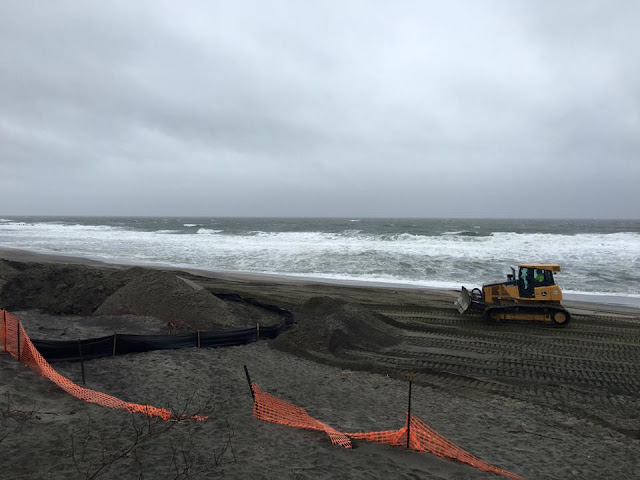Thanks
to the watchful citizens in the Deal area who, on Friday, February 19, posted pictures of material being
dumped at the tide line and into the ocean at Phillips Avenue in Deal, NJ.
Clean Ocean Action immediately contacted Federal, State, and Local agencies,
prompting them to further investigate the matter. This is a summary
of what we know so far, and what areas COA is investigating further.
Photo by Phil Browne
The material
is from the construction of a federal outfall project for Poplar Brook, which
is a part of the ongoing Sea Bright to Manasquan
Beach Erosion Control Project (specifically the Elberon to Loch Arbor reach of
this massive project), along the coast of New Jersey.[1]
It
is not dredged material or part of the Federal beach replenishment project.
This project is overseen by the US Army Corps of Engineers (USACE). USACE
contracted with Manson Construction Company.[2]
Manson Construction Company subcontracted work on the construction of outfalls
to Agate Engineering. COA is in the process of getting the contract and project
specifications for this reach of the Beach Erosion Control Project; however
what we do know is that the subcontractor was supposed to remove the
material offsite and properly dispose of it.[3]
Photo by Phil Browne
The
sub-contractor, Agate Engineering, ILLEGALLY dumped the material on the beach
and into the ocean in violation of its contract with the USACE, as well as
several State and Federal environmental laws. This activity may have started as
early as Wednesday, February 17,
according to one eyewitness.[4]
By the afternoon of the 19th,
the US Army Corps had been notified by COA and NJDEP, and "the
contractor was ordered immediately to stop work and begin removing the material
out of the surf zone and relocating it upland until it could be properly
disposed as is required by the contract plans and specifications.”[5]
photo by Zach Lees
Photo by Zach Lees
Photo by Zach Lees
Unfortunately, the waterline from that morning’s high tide seemed to have come right up and onto the pile, potentially releasing more of the material into the ocean. Furthermore, the waterline at low tide was so close to the pile of material that it seemed likely that the next high tide would certainly put the sand berm and pile of material in line with the rising water. Furthermore, the pile of material from the outfall construction had grown even larger, with even more of the dark and debris filled material added to the original pile:
Photo by Zach Lees
We
again visited Tuesday Afternoon (at low tide), Tuesday Evening (approaching
high tide) and Wednesday Morning (just after high tide), to make sure the high tide and storm surge did
not breach the sand berm. Fortunately, the berm appears to be doing its job of
containing the material from the ocean for the time being:
Photo by Zach Lees
Photo by Zach Lees
Photo by Zach Lees
As stated earlier, the material pile had grown in size from Monday
to Tuesday afternoon, as the subcontractor appears to have no other place to
put this material (other than illegally dumping it into the ocean). We
are working to make sure the pile of muck is removed from the beach and
properly disposed of as quickly as possible, however, for the time
being, we can only continue to investigate and monitor the situation to make
sure that the material pile is properly managed where it is.
We have attached the Notice of Violation NJDEP sent to Agate Engineering on February 22. See below:
[1]http://www.nan.usace.army.mil/Media/FactSheets/FactSheetArticleView/tabid/11241/Article/487661/sea-bright-to-manasquan-nj-beach.aspx,
“The Sea
Bright to Manasquan Project covers 21 miles of the New Jersey shoreline and is
the largest beach nourishment project ever undertaken by the Corps of
Engineers, and is the largest beachfill project, in terms of volume, in the
world.”
[2]
http://www.nan.usace.army.mil/Media/NewsReleases/tabid/3948/Article/616581/army-corps-awards-contract-for-monmouth-county-nj-coastal-project.aspx
[4]
COA talked with Bill Senck, who also took photographs of this activity and
worked with COA and press to document this activity.













No comments:
Post a Comment